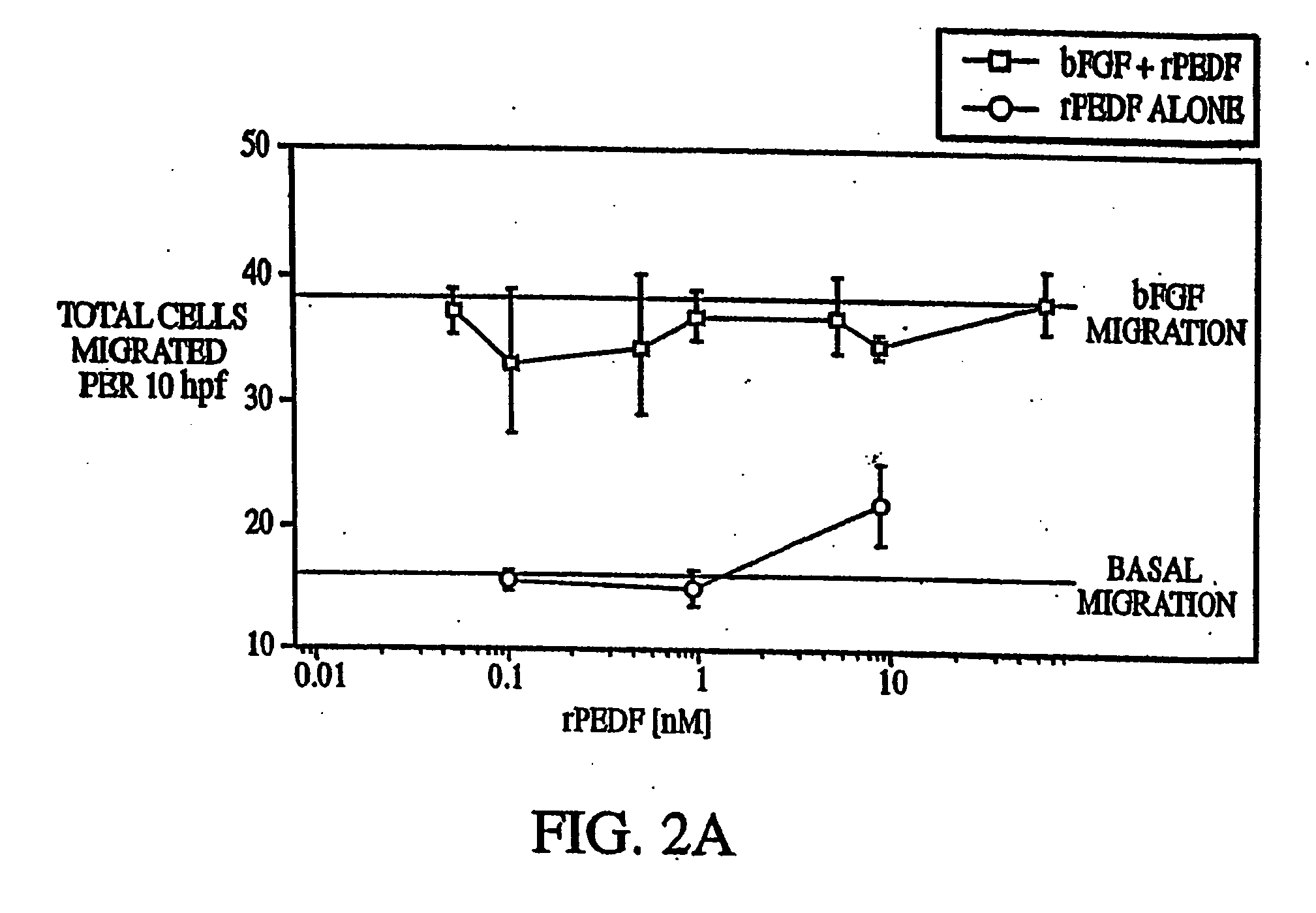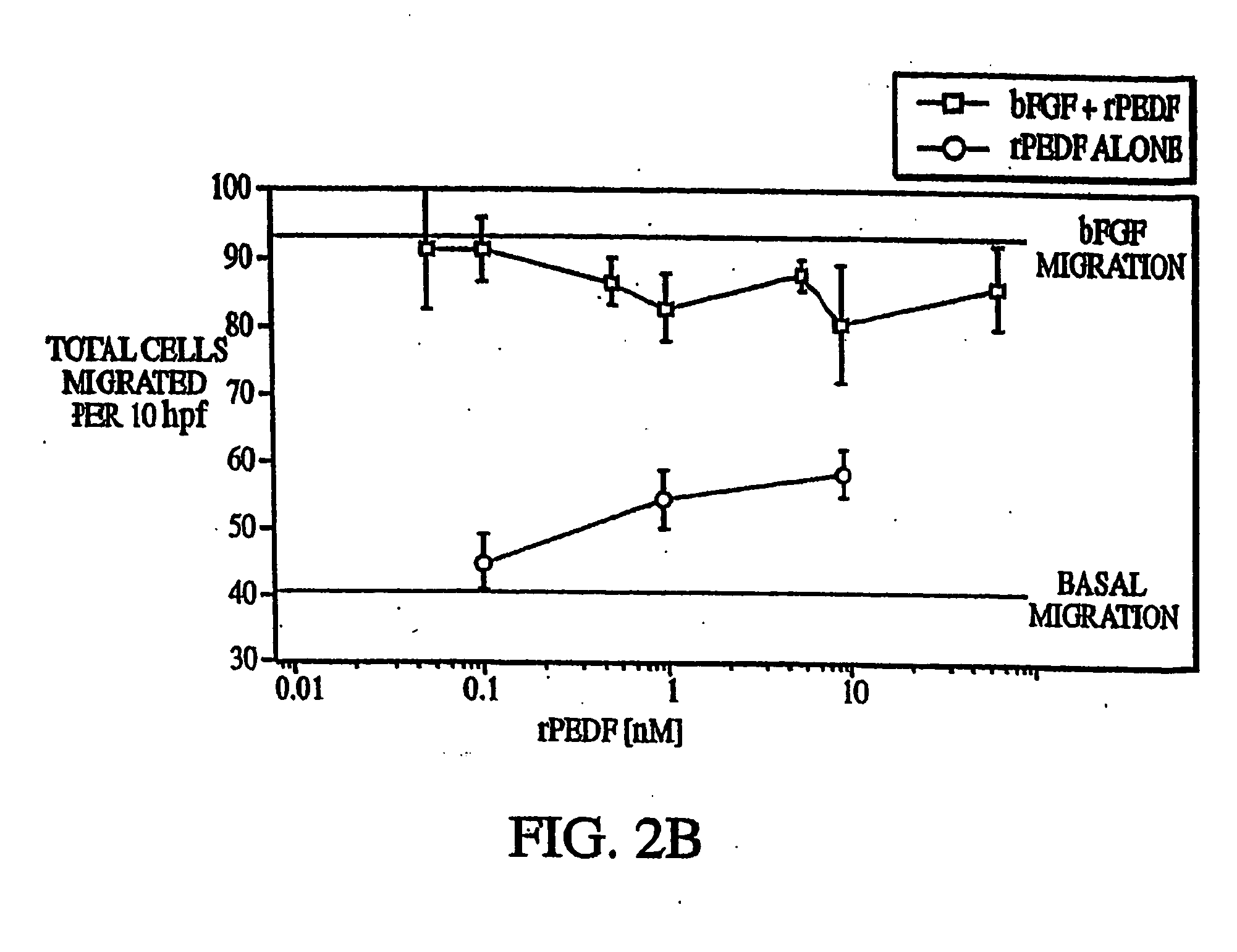Methods and compositions for inhibiting angiogenesis
an angiogenesis and composition technology, applied in the direction of angiogenin, instruments, peptide/protein ingredients, etc., can solve the problems of bleeding and blindness, rapid proliferation and turnover, and turnover rate of five days
- Summary
- Abstract
- Description
- Claims
- Application Information
AI Technical Summary
Benefits of technology
Problems solved by technology
Method used
Image
Examples
example 1
[0182] The data presented herein demonstrate that PEDF prevents endothelial cell migration.
[0183] The migration of different vascular endothelial cell types was determined by adding PEDF to cultured endothelial cells, specifically, endothelial cells isolated from bovine adrenal capillaries, human umbilical chords, and human dermal microvascular tissue.
[0184] The cells were plated on gelatinized Nucleopore membranes (5 μm pores for bovine capillary cells and 8 μm pores for other cells) in an inverted modified Boyden chamber. After two hours, the chamber was reinverted and test substances added to the top wells of each. Specifically, populations were exposed to either culture medium alone (control), 10 ng / ml bFGF, 2 nM PEDF (full length PEDF), or both 10 ng / ml bFGF (basic fibroblast growth factor) and 10 nM PEDF. The cells were then permitted to migrate for 34 hours. Following this, the membranes were fixed and stained, and the number of cells that had migrated were counted.
[0185] ...
example 2
[0186] The data presented herein demonstrate that the prevention of cell migration by PEDF is specific for endothelial cells.
[0187] The ability of PEDF to prevent migration of fibroblasts or smooth muscle was tested using cells obtained from human diploid fibroblast cell line WI-38, human foreskin fibroblasts, vascular smooth muscle, and normal human neutrophils.
[0188] The assay was performed as indicated in Example 1, except that the dose of PEDF varied from 0.01 nM to about 50 nM and that the migration assay was performed without inverting the chambers. Moreover, the inducer of migration varied with the cell type (IL-8 was used at 1 μg / ml and PDGF was used at 250 pg / ml).
[0189] The results of this experiment are presented in FIGS. 2A-2D. As indicated in these figures, PEDF did not inhibit migration of any of the cell lines. This result indicates that the antimigratory activity of PEDF is specific for vascular endothelial cells.
example 3
[0190] The data presented herein demonstrate that PEDF is among the most potent inhibitors of endothelial cell migration when compared with other antiangiogenic factors.
[0191] Using a protocol similar to that outlined in Example 1, bovine adrenal capillary endothelial cells were exposed to bFGF, PEDF, and several known antiangiogenic factors. The amount of a given factor necessary to achieve 50% of migration was determined and is reported here as ED50. A smaller ED50 measurement indicates a more potent antiangiogenic factor. The results of this experiment, presented in Table 1, indicate that PEDF is a highly potent antiangiogenic factor.
TABLE 1AgentED50 (nM)PEDF0.1-0.5Thrombospondin0.5Endostatin3.0Angiostatin3.5Retinoic Acid15Tissue Inhibitor of Metalloproteinase-13500Captopril10,000
PUM
| Property | Measurement | Unit |
|---|---|---|
| turnover time | aaaaa | aaaaa |
| diameter | aaaaa | aaaaa |
| pH | aaaaa | aaaaa |
Abstract
Description
Claims
Application Information
 Login to View More
Login to View More - R&D
- Intellectual Property
- Life Sciences
- Materials
- Tech Scout
- Unparalleled Data Quality
- Higher Quality Content
- 60% Fewer Hallucinations
Browse by: Latest US Patents, China's latest patents, Technical Efficacy Thesaurus, Application Domain, Technology Topic, Popular Technical Reports.
© 2025 PatSnap. All rights reserved.Legal|Privacy policy|Modern Slavery Act Transparency Statement|Sitemap|About US| Contact US: help@patsnap.com



